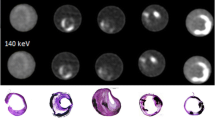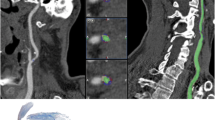Abstract
We evaluated quantification of calcified carotid stenosis by dual-energy (DE) CTA and dual-energy head bone and hard plaque removal (DE hard plaque removal) and compared the results to those of digital subtraction angiography (DSA). Eighteen vessels (13 patients) with densely calcified carotid stenosis were examined by dual-source CT in the dual-energy mode (tube voltages 140 kV and 80 kV). Head bone and hard plaques were removed from the dual-energy images by using commercial software. Carotid stenosis was quantified according to NASCET criteria on MIP images and DSA images at the same plane. Correlation between DE CTA and DSA was determined by cross tabulation. Accuracies for stenosis detection and grading were calculated. Stenosis could be evaluated in all vessels by DE CTA after applying DE hard plaque removal. In contrast, conventional CTA failed to show stenosis in 13 out of 18 vessels due to overlapping hard plaque. Good correlation between DE plaque removal images and DSA images was observed (r 2 = 0.9504) for stenosis grading. Sensitivity and specificity to detect hemodynamically relevant (>70%) stenosis was 100% and 92%, respectively. Dual-energy head bone and hard plaque removal is a promising tool for the evaluation of densely calcified carotid stenosis.





Similar content being viewed by others
References
North American Symptomatic Carotid Endarterectomy Trial Collaborators (1991) Beneficial effect of carotid endarterectomy in symptomatic patients with high-grade carotid stenosis. N Engl J Med 325:445–453
European Carotid Surgery Trialists’ Collaborative Group (1991) MRC European Carotid Surgery Trial: interim results for symptomatic patients with severe (70–99%) or with mild (0–29%) carotid stenosis. Lancet 337:1235–1243
Barnett HJ, Taylor DW, Eliasziw M et al (1998) Benefit of carotid endarterectomy in patients with symptomatic moderate or severe stenosis. North American Symptomatic Carotid Endarterectomy Trial Collaborators. N Engl J Med 339:1415–1425
Anderson GB, Ashforth R, Steinke DE, Ferdinandy R, Findlay JM (2000) CT angiography for the detection and characterization of carotid artery bifurcation disease. Stroke 31:2168–2174
Moll R, Dinkel HP (2001) Value of the CT angiography in the diagnosis of common carotid artery bifurcation disease: CT angiography versus digital subtraction angiography and color flow Doppler. Eur J Radiol 39:155–162
Randoux B, Marro B, Koskas F et al (2001) Carotid artery stenosis: prospective comparison of CT, three-dimensional gadolinium-enhanced MR, and conventional angiography. Radiology 220:179–185
Josephson SA, Bryant SO, Mak HK, Johnston SC, Dillon WP, Smith WS (2004) Evaluation of carotid stenosis using CT angiography in the initial evaluation of stroke and TIA. Neurology 63:457–460
Lell M, Fellner C, Baum U et al (2007) Evaluation of carotid artery stenosis with multisection CT and MR imaging: influence of imaging modality and postprocessing. AJNR Am J Neuroradiol 28:104–110
Silvennoinen HM, Ikonen S, Soinne L, Railo M, Valanne L (2007) CT angiographic analysis of carotid artery stenosis: comparison of manual assessment, semiautomatic vessel analysis, and digital subtraction angiography. AJNR Am J Neuroradiol 28:97–103
Saba L, Sanfilippo R, Pirisi R, Pascalis L, Montisci R, Mallarini G (2007) Multidetector-row CT angiography in the study of atherosclerotic carotid arteries. Neuroradiology 49:623–637
Johnson TR, Krauss B, Sedlmair M et al (2007) Material differentiation by dual energy CT: initial experience. Eur Radiol 17:1510–1517
Flohr TG, McCollough CH, Bruder H et al (2006) First performance evaluation of a dual-source CT (DSCT) system. Eur Radiol 16:256–268
Venema HW, Hulsmans FJ, den Heeten GJ (2001) CT angiography of the circle of Willis and intracranial internal carotid arteries: maximum intensity projection with matched mask bone elimination-feasibility study. Radiology 218:893–898
Tomandl BF, Hammen T, Klotz E, Ditt H, Stemper B, Lell M (2006) Bone-subtraction CT angiography for the evaluation of intracranial aneurysms. AJNR Am J Neuroradiol 27:55–59
Lell MM, Ditt H, Panknin C et al (2007) Bone-subtraction CT angiography: evaluation of two different fully automated image-registration procedures for interscan motion compensation. AJNR Am J Neuroradiol 28:1362–1368
Silvennoinen HM, Ikonen S, Soinne L, Railo M, Valanne L (2007) CT angiographic analysis of carotid artery stenosis: comparison of manual assessment, semiautomatic vessel analysis, and digital subtraction angiography. AJNR Am J Neuroradiol 28:97–103
Author information
Authors and Affiliations
Corresponding author
Rights and permissions
About this article
Cite this article
Uotani, K., Watanabe, Y., Higashi, M. et al. Dual-energy CT head bone and hard plaque removal for quantification of calcified carotid stenosis: utility and comparison with digital subtraction angiography. Eur Radiol 19, 2060–2065 (2009). https://doi.org/10.1007/s00330-009-1358-x
Received:
Revised:
Accepted:
Published:
Issue Date:
DOI: https://doi.org/10.1007/s00330-009-1358-x




